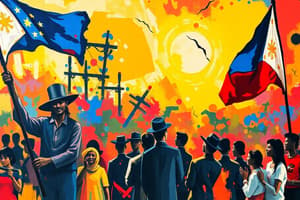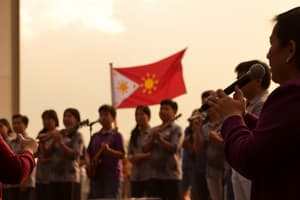Podcast
Questions and Answers
What was the original title of the Philippine national anthem before it was renamed?
What was the original title of the Philippine national anthem before it was renamed?
- Lupang Hinirang
- Filipinas
- Marcha Filipina Magdalo (correct)
- Marcha Nacional Filipina
Who was appointed to compose the march music for the revolutionists?
Who was appointed to compose the march music for the revolutionists?
- Jose Palma
- Julian Felipe (correct)
- Felipe de Leon
- Emilio Aguinaldo
In which language was the poem 'Filipinas' originally written?
In which language was the poem 'Filipinas' originally written?
- Filipino
- English
- Tagalog
- Spanish (correct)
Why was the poem later translated into Filipino?
Why was the poem later translated into Filipino?
According to Republic Act 8491, what must people do when the national anthem is played?
According to Republic Act 8491, what must people do when the national anthem is played?
What is the purpose of the national symbols like the anthem in the context of the Philippines' history?
What is the purpose of the national symbols like the anthem in the context of the Philippines' history?
Who translated the poem 'Filipinas' into Filipino?
Who translated the poem 'Filipinas' into Filipino?
For how long did the anthem remain without lyrics after its composition?
For how long did the anthem remain without lyrics after its composition?
What must attendees do during the singing of the Lupang Hinirang?
What must attendees do during the singing of the Lupang Hinirang?
What is the significance of Southeast Asian dance according to the content?
What is the significance of Southeast Asian dance according to the content?
Which character is not depicted in the Lakhon Chatri dance?
Which character is not depicted in the Lakhon Chatri dance?
What type of dance is Lakhon Nai?
What type of dance is Lakhon Nai?
How is the Lakhon Nai dance described in terms of its movements?
How is the Lakhon Nai dance described in terms of its movements?
What role does traditional dance play in Thai culture?
What role does traditional dance play in Thai culture?
Who is believed to have sponsored the redevelopment of Lakhon Nai in the early 19th century?
Who is believed to have sponsored the redevelopment of Lakhon Nai in the early 19th century?
What elements are highlighted in the vibrant aspect of Thai traditional dance?
What elements are highlighted in the vibrant aspect of Thai traditional dance?
Flashcards
Philippines' colonial period
Philippines' colonial period
The Philippines was ruled by Spain for 333 years.
"Lupang Hinirang" origin
"Lupang Hinirang" origin
"Lupang Hinirang"'s music was composed by Julian Felipe in 1898.
Jose Palma's role
Jose Palma's role
Jose Palma wrote the Spanish poem "Filipinas" for the "Lupang Hinirang".
Translation of "Filipinas"
Translation of "Filipinas"
Signup and view all the flashcards
RA 8491 (Flag and Heraldic Code)
RA 8491 (Flag and Heraldic Code)
Signup and view all the flashcards
Importance of "Lupang Hinirang"
Importance of "Lupang Hinirang"
Signup and view all the flashcards
Spanish language lyrics
Spanish language lyrics
Signup and view all the flashcards
Filipino lyrics adoption
Filipino lyrics adoption
Signup and view all the flashcards
What is the "Lupang Hinirang"?
What is the "Lupang Hinirang"?
Signup and view all the flashcards
What is the RA 8491?
What is the RA 8491?
Signup and view all the flashcards
How is respect shown during the "Lupang Hinirang"?
How is respect shown during the "Lupang Hinirang"?
Signup and view all the flashcards
What is Southeast Asian dance?
What is Southeast Asian dance?
Signup and view all the flashcards
Purpose of Traditional Dance
Purpose of Traditional Dance
Signup and view all the flashcards
Lakhon Chatri
Lakhon Chatri
Signup and view all the flashcards
Lakhon Nai
Lakhon Nai
Signup and view all the flashcards
What are the characteristics of Thai traditional dance?
What are the characteristics of Thai traditional dance?
Signup and view all the flashcards
Study Notes
Background on Philippine Music
- The Philippines was a Spanish colony for 333 years, leading to a fight for freedom.
- In 1898, Gen. Emilio Aguinaldo appointed Julian Felipe to compose a revolutionary march.
- The original title was "Marcha Filipina Magdalo," later renamed "Marcha Nacional Filipina," the tune of "Lupang Hinirang."
- Initially, the anthem lacked lyrics for approximately a year.
- Jose Palma then wrote the Spanish poem "Filipinas."
Reasons for Spanish Lyrics
- The poem was written in Spanish to fully capture the strong Filipino patriotism.
- It's unclear exactly why Jose Palma chose to write in Spanish, but the translated lyrics better reflected the sentiments of the revolution.
- If Jose Palma were writing today, the motive might be similar to fully express the fervor and patriotic feelings of the people.
Transformation of Lupang Hinirang (National Anthem)
- The Spanish poem "Filipinas" was later translated into Filipino by Felipe de Leon.
- Today, the anthem is sung in Filipino.
Anthem Usage in Flag Ceremonies
- According to Republic Act 8491, "Lupang Hinirang" (the national anthem) must be played or sung during flag ceremonies in schools, offices, and other events.
- The public must sing with enthusiasm and respect, standing at attention, facing the flag, and placing their right hand over their left chest.
Southeast Asian Dance
- Southeast Asian dance is a vibrant and expressive art form reflecting the region's rich cultural heritage.
- Traditionally performed in villages and open fields
Studying That Suits You
Use AI to generate personalized quizzes and flashcards to suit your learning preferences.




